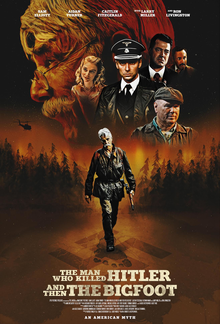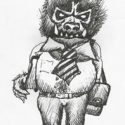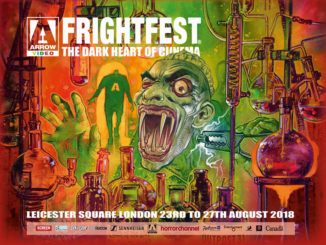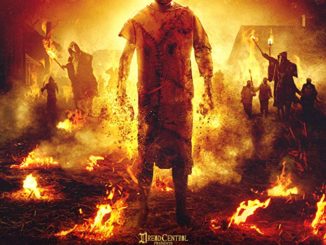The Man Who Killed Hitler And Then The Bigfoot

To round off our Fright Fest coverage, I had the honours of sitting down to interview The Man Who Killed Hitler Then The Bigfoot helmer Robert D. Krzykowski. Being the clear stand out of the festival for me, getting my number one rank for the five days and my only five star review, I was extremely excited to meet him in the hotel lobby. There, we talked about his directorial debut, the writing process, managing a budget, the secrets to a great score and making Nazi watches. But first, we had to talk about that name. Please note this interview contains plot details, that may be considered mild spoilers, though we discussed no specifics outside the title. The order has also been slightly tweaked from the day.
HCF: So first, I got to ask about the name. It’s bold, and brilliant, though does it give the impression of a Troma style comedy?
When I conceived the title it felt like it explained everything the movie was going to be, so there’d be no surprises about the strangeness of the movie. People could choose to see it or not, knowing what they’re going in to. If it had a simpler title, you’re tricking them to see something with these crazy elements – and that’s a different conversation. So it’s which conversation do we want to have with the audience first and how do we want them to confront what we’re doing.
HCF: Brining it here, were you nervous about showing it to a horror audience?
When Fright Fest contacted us I thought I sure hope it doesn’t alienate a segment of the audience. But the more I thought about it, the more I realised genre fans are usually on the cutting edge of discovering new, interesting stories, and new ways to tell them – they embrace uniqueness. And I stopped worrying about it and trusted that it didn’t matter what the subject was – that it’s fantastic and bizarre would hopefully be enough for them – and the emotional themes would resonate as well.
HCF: In the critics’ section, we got young critics and then the sixty year olds. And both groups got something from it. You got the idealism of the young man, then the autumn years later on.
I felt like this movie had the potential to reach a lot of different groups. It has a beautiful romance at the core, then this family element with his brother – that love story is as important, and not many films document the love between two brothers like this. It has adventure elements, horror elements. And in the end its kind of a parable about how we treat one another, decency and the path not taken. These were the things I hoped the audience would open to if they embraced the strangeness of it.
HCF: There’s a great contrast between the character’s fantastical life and the very normal things he’s concerned with.
When I was writing it I’d go through some personal losses, and I felt like creating this mythic hero who shares our frailties may give people courage. It’s something I thought about a lot while I was writing him – just trying to find this good, decent core to the character. And the more I chased that, the more the film you saw revealed itself to me.
HCF: Did casting Sam Eliot change how you viewed the character?
If anything, casting Sam crystallised the character for me. Because he took the entire concept so seriously – he wanted to find the reality in it. So every day he was doing that, the movie became more and more real to me. If anything, he makes the movie more straight faced, while elements at the outer edges inform it.
HCF: He really brings it to that scene where he’s asked to come back for one more job, and it’s played so straight, when he’s told about the Bigfoot.
Zach Passero and I were editing that sequence, and we knew that when Rizwan (Manji) said Bigfoot it was going to get a laugh – you couldn’t help it. And the scene is so serious that you need that pressure release. So we tried to time it, all of the cuts from Sam, to Ron Livingston, back to Sam, back to Ron as long as it would take the audience to laugh – then get back to the seriousness of it.
HCF: And then we see the fight scene itself. Although the Bigfoot is dispatched in such a matter of fact way, the fight itself gets so bombastic.
In the eleventh hour I wanted to give the audience the catharsis they’d been looking for – and I thought it’d be a chance to have this kinetic fight scene where Bigfoot is throwing up on Sam and you’re getting all these exploitative promises of the movie. But again, just before that, Sam’s holding the Bigfoot’s hand and weeping. Then when he does the deed he does it in a very resigned, painful way. So it’s bookended by the seriousness of having to kill anything – the theme of the movie is what does it mean to take a life and what toll does it take on you.
HCF: Right – it’s also there when he says he hated taking a life in the war, even though he had it coming to him
Exactly, he didn’t feel good about it. And he knows Hitler deserved exactly what he got coming to him. He just didn’t feel he personally was the right candidate to have done it. But, in fact, there wasn’t anyone else who could have done.
HCF: He then dismisses it by saying it didn’t even matter because the symbolism lives on.
Well that was the writing challenge – how can we in 2018 believe that in 1987 there’s even a whisper of a chance this could have happened. Because if we can explain that history marched on, like we’ve read about, a lot of the craziness in the script becomes more passable.
HCF: Was it always envisioned as Hitler and the Bigfoot he would kill?
It’s the strangest thing – I started the first ten pages and it opened like a James Bond movie with him killing Hitler, and I didn’t have anything else in mind. I think it was 2003 I wrote the first pages, then I didn’t really pick it up for a couple of years, and get serious about it. But in those ten pages you got this incredible thing happen. I really liked the hero – I thought he could be interesting. I thought he could be this pulp unknown hero like a John Steinbeck character, but I realised I can’t top myself in the script – I’d killed Hitler in the first ten pages, so what’s the next thing he could come up against that’s mythic and difference. And I just had this flash – what if it was Bigfoot, but it took it completely seriously. Then I came up with this reason for why he’d have to go kill Bigfoot. So it all came within the first ten pages, then the title came the same day and that never changed.
HCF: Elsewhere, I loved the relationship he had with his brother
Larry (Miller) is beautiful in this movie.
HCF: The promise of the fishing bit brought a tear to the eye.
He brought such a sweet human kindness – and such a believability. He helps sell some of the most bizarre moments. He draws Sam out, to admit to killing somebody in the war. Even if Ed doesn’t know who he is, he lets the audience experience the flashback. Then later on the park bench he’s the only person close enough to Barr to get the information he’s killing Bigfoot. Then Larry’s response is very matter of fact – and it’s all because he believes his brother to be an honourable man.
HCF: I saw you worked as a producer before – I’ve seen The Woman, by Lucky McKee. Would you say this time prepared you much for being a director?
I was more nervous about directing than I ever was producing, but what it did was make me hyper aware of the realities of the shoot. So I understood when somebody told me you can’t have this, and they could give me rock solid reasons and that meant we’d have a creative pivot to something equally exciting. Or entirely unnoticeable so the audience were still feeling the story. So it prepared me to the realities of independent filmmaking. Then coming up with creative solutions to what might seem like problems but were really just a creative dance where you have to find another way to do what you want to do.
HCF: Given the low budget, your period details looked outstanding
Our production designer, Brett Hatcher, and me had several phone conversations where we discussed how we’re going to pull this off and the big trick was every single element of the movie all takes place within ten minutes of my front door in Massachusetts. So all this jumping around timelines, then Canada and Poland, it’s all in a really, really close area. And Brett just found resources, he turned over every stone, and found ways to make the movie feel real and shockingly large. Then my brother found all the picture cards for the movie, while Brett and his department made all these props that looked authentic and aged. Everyday I’d see something out of the script, that I never knew I’d be holding – beautiful props like the swastika watch – he had to take that to the jeweller and have that made. That’s a really strange thing to have to ask for, then explain it’s a surreal element in the movie. It won’t even make sense, but it always gets a laugh because it’s the first thing to let you know its ok to accept it as a bit of a fantasy.
HCF: It got a good titter in my screening too – though I think we were all wondering how it’d even tell time.
It doesn’t tell time (laughs) it’s just literally Nazi-O’clock
HCF: And the cinematography’s great too – it looked excellent on the big screen.
When we finished it, at Skywalker, we screened it on George Lucas’ big, massive theatre, and it was the first time I’d seen it big. It has such a texture and quality to the image – Alex Vendler’s photography is just stunning. We spent a lot of time on the visual science to make it have two distinct looks without being jarring. So 1987 has its own grain and colour palette – but also things we won’t do for it, but embrace in the 1940s where there’s more of a technicoloured Hitchcock look, but not going far enough to be pastiche. We wanted it to be right on the edge of perception and Alex was just so game to try interesting experiments with the image that can look like it fell out of 1987 but not look like any one movie – it was meant to be more of a feeling.
HCF: It didn’t revel in the phoney nostalgia like a lot of other modern horrors
Yeah, I was born in 1984, so I remember the early 90s more. But it hadn’t changed much – especially not in western Massachusetts because everyone was ten years later on everything anyhow. It didn’t look like a 1980s music video – it just looked like people dressed up lamely. When we talked about the look, we wanted it to be a very small town 87 without drawing on the pop culture of the era.
HCF: And that soundtrack too! Particularly moment as he’s climbing the hill to face the monster
Joe Kraemer and I had been talking about this movie for two years, and our big influences were John Williams, David Shire, Benjamin Herman – and I think Joe delivered that brilliantly. It’s also a testament to how talented and unique he is because it has the flavours of those composers but is its own unique thing too. And I really miss scores that have themes – that’s reseeded a bit, with people wanting more texture from the music rather than it being part of the storytelling. And Joe is a storyteller – he’s a great filmmaker with a really intelligent film theory. If Joe wasn’t a composer, he’d be one of the great film editors. And so when you’re collaborating with Joe you’re not just getting an orchestral composition – you’re getting a collaborator who helps shape the story. As he’s watching cuts he’s still thinking about character, he’s sending notes to make it the best film it can be. Then as starts delivering the score you realise he’s so connected emotionally to the material – he starts illuminating things you didn’t know about and tying it together with various subtle themes in places you’d never expect to see them to remind you of a character. Like if a character is thinking of another character. What was really exciting about hearing his score come in was him shining a light on all the places you as a director weren’t even aware of to bring even more character or thematic depth.
HCF: This has been one of the more ambitious feature debuts I can think of. Have you got your next projects lined up?
I have a couple of things I feel really passionate about – when this whole process is done, like the festival circuit and wrapping everything up as a producer, I’m really looking forward to getting back to the writing desk. I got a couple of things I’d like to put to paper, and a couple of things I’ve written that’d also be excited about. So it’s really about if I’m fortunate enough to do this again.
HCF: You know, I’m surprised we’re about the same age – not in a bad way, but because of how reflective the piece is. Were you always drawn to this aged, faded masculinity – like Rambo after the Rambo movies?
Yeah, I was interested in telling the story of an older man looking backwards with fear and regret rather than a young man looking forward with courage and hope. I thought there could be hope at the end of this journey, but we’d have to earn it. And so, I think as he’s experiencing all this pain, loneliness, and the PTSD – all these things are nagging at him, as represented by some of the symbolic elements like the stone in the shoe. Whether or not he finds relief is one of the, I hope, joys in the movie.
HCF: You got a few of these symbols – like the toy dinosaur for purity – then there’s this mystery box…
This idea of a mystery box has been used for over a hundred years, but this idea for me was to leave something with the audience. If you’ve been paying attention to the movie, you’ve been following the character and you’re invested in him, then there’s obviously something deeply personal in there. But it’s entirely unimportant because it allows the audience to put something into themselves that they have ownership over – that they can talk to their friends and speculate about, or fill it with something meaningful. I like when movies let the audience be a participant rather than a passive observer.
HCF: Did you and Sam discuss what it was?
I didn’t tell him during production, because I wanted him to get a mysterious feeling around it – because he never confronts it during the movie. I never wanted to have that look on his face of ‘here’s what this is’ – I wanted it to have that constant edge about it. So maybe Sam not knowing what it is would read to the audience as either fear or loss. The way he performed it not knowing was so good, I wanted to preserve that. But finally when we finished it was driving him so crazy not to know so I wrote a tiny amendment for so he’d know.
HCF: Go on, break it to us as an exclusive?
(Laughs) I really can’t say.
HCF: Can’t blame a guy for trying. I’ll re-watch and draw my own conclusions.
There you go, and I think it can be figured out, what I think it is. But I’ve also heard other people put things in it that are extremely meaningful and just as valid. It’s not ultimately about what’s in it though – it’s about his need to go back to reclaim and confront it when he’s ready. And I believe it’s a good thing, and a hopeful thing.
HCF: Thank you very much
It’s a pleasure.
There is no release confirmed for The Man Who Killed Hitler And Then The Bigfoot, though for the news as it comes in watch this space.





Be the first to comment